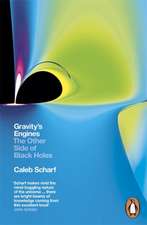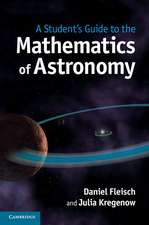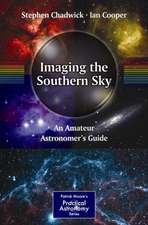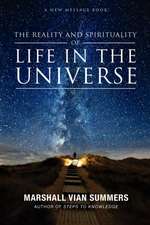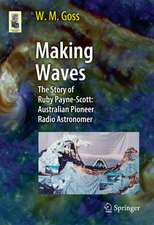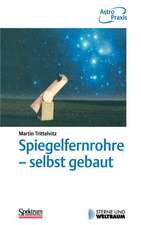Exploring the Cosmic Frontier: Astrophysical Instruments for the 21st Century: ESO Astrophysics Symposia
Editat de A.P. Lobanov, J.A. Zensus, C. Cesarsky, Ph. Diamonden Limba Engleză Hardback – 7 noi 2006
On May 18-21, 2004, the Max-Planck-Society’s Harnack-Haus in Dahlem, Berlin hosted the international symposium "Exploring the Cosmic Frontier: Astrophysical Instruments for the 21st Century". The symposium in Berlin was dedicated to exploring the complementarity and synergies between different branches of astrophysical research, by presenting and discussing the fundamental scientific problems that will be addressed by major future astrophysical facilities in the next few decades.
This book contains 70 papers from the meeting and is intended to give a lasting account of a snapshot of an evolving scientific discourse and interaction throughout our field of research.
| Toate formatele și edițiile | Preț | Express |
|---|---|---|
| Paperback (1) | 560.86 lei 39-44 zile | |
| Springer Berlin, Heidelberg – 30 noi 2010 | 560.86 lei 39-44 zile | |
| Hardback (1) | 644.95 lei 6-8 săpt. | |
| Springer Berlin, Heidelberg – 7 noi 2006 | 644.95 lei 6-8 săpt. |
Din seria ESO Astrophysics Symposia
- 15%
 Preț: 656.43 lei
Preț: 656.43 lei - 15%
 Preț: 656.10 lei
Preț: 656.10 lei -
 Preț: 369.78 lei
Preț: 369.78 lei -
 Preț: 404.51 lei
Preț: 404.51 lei - 15%
 Preț: 656.43 lei
Preț: 656.43 lei -
 Preț: 391.97 lei
Preț: 391.97 lei - 18%
 Preț: 971.01 lei
Preț: 971.01 lei -
 Preț: 434.94 lei
Preț: 434.94 lei - 15%
 Preț: 650.86 lei
Preț: 650.86 lei -
 Preț: 402.98 lei
Preț: 402.98 lei -
 Preț: 403.90 lei
Preț: 403.90 lei -
 Preț: 412.78 lei
Preț: 412.78 lei - 15%
 Preț: 645.47 lei
Preț: 645.47 lei -
 Preț: 431.30 lei
Preț: 431.30 lei - 15%
 Preț: 649.06 lei
Preț: 649.06 lei -
 Preț: 402.56 lei
Preț: 402.56 lei - 15%
 Preț: 647.27 lei
Preț: 647.27 lei -
 Preț: 413.15 lei
Preț: 413.15 lei -
 Preț: 409.30 lei
Preț: 409.30 lei -
 Preț: 430.10 lei
Preț: 430.10 lei -
 Preț: 406.42 lei
Preț: 406.42 lei - 15%
 Preț: 658.05 lei
Preț: 658.05 lei - 20%
 Preț: 590.37 lei
Preț: 590.37 lei -
 Preț: 400.65 lei
Preț: 400.65 lei -
 Preț: 413.15 lei
Preț: 413.15 lei - 15%
 Preț: 658.70 lei
Preț: 658.70 lei -
 Preț: 401.79 lei
Preț: 401.79 lei -
 Preț: 436.70 lei
Preț: 436.70 lei -
 Preț: 404.13 lei
Preț: 404.13 lei
Preț: 644.95 lei
Preț vechi: 758.77 lei
-15% Nou
Puncte Express: 967
Preț estimativ în valută:
123.41€ • 129.22$ • 102.36£
123.41€ • 129.22$ • 102.36£
Carte tipărită la comandă
Livrare economică 10-24 aprilie
Preluare comenzi: 021 569.72.76
Specificații
ISBN-13: 9783540397557
ISBN-10: 3540397558
Pagini: 270
Ilustrații: XXIV, 246 p.
Dimensiuni: 155 x 235 x 18 mm
Greutate: 0.54 kg
Ediția:2007
Editura: Springer Berlin, Heidelberg
Colecția Springer
Seria ESO Astrophysics Symposia
Locul publicării:Berlin, Heidelberg, Germany
ISBN-10: 3540397558
Pagini: 270
Ilustrații: XXIV, 246 p.
Dimensiuni: 155 x 235 x 18 mm
Greutate: 0.54 kg
Ediția:2007
Editura: Springer Berlin, Heidelberg
Colecția Springer
Seria ESO Astrophysics Symposia
Locul publicării:Berlin, Heidelberg, Germany
Public țintă
ResearchCuprins
Future Astrophysical Facilities.- Radio Astronomy Facilities.- Future Optical and Near-Infrared Facilities.- The New 40-m Radiotelescope of OAN in Yebes, Spain.- Design of the Near-term Next Generation Space-VLBI Mission VSOP-2.- Imaging Across the Spectrum: Synergies Between SKA and Other Future Telescopes.- The Korean VLBI Network Project.- Frequency Protection for the 21st Century.- SCUBA-2: A Large-Format CCD-Style Imager for Submillimeter Astronomy.- The Large Millimeter Telescope.- An Overview of the Submillimeter Array Telescope.- Tunable Heterodyne Receivers - A Promising Outlook for Future Mid-Infrared Interferometry.- ESPRIT – Exploratory Submillimeter sPace Radio Interferometric Telescope.- Fizeau Interferometry with the LBT Astronomy on the Way to ELTs.- MUSE: 3D Spectroscopy with Large Telescopes.- Layer-Oriented MCAO Projects for 8-m Class Telescopes and Possible Scientific Outcome.- Prospects for an Extremely Large Synthesis Array.- Interferometry in the Near-Infrared: 1 Mas Resolution at the Wavelength of 1 Micron.- Electrical and Geometrical Characterization of the Silicon Flight Sensors of the GLAST/LAT Tracking System.- Environmental Testing of the GLAST Tracker Subsystem.- The Potential of a Large Cherenkov Array for Supersymmetry and Cosmology.- MAGIC: First Observational Results and Perspectives for Future Developments.- LOBSTER - Astrophysics with Lobster Eye Telescopes.- Novel Light-Weight X-ray Optics for Future X-ray Telescopes.- GLAST LAT Science Prospects.- Astrophysics with Astronomical Plate Archives.- Virtual Observatories and Access to Radio Interferometry Data.- Fundamental Physics and Cosmology.- Fundamental Physics with the SKA: Strong-Field Tests of Gravity Using Pulsars and Black Holes.- Measuring Variations in the FundamentalConstants with the Square Kilometre Array.- ELT Observations of Supernovae at the Edge of the Universe.- SKA and the Magnetic Universe.- SSF as a Manifestation of Protoobjects in the Dark Ages Epoch: Theory and Experiment.- Cosmic Ray Astrophysics with AMS-02.- Studying the Nature of Dark Energy with Current and Future Instruments.- Project ASTRAL: All-sky Space Telescope to Record Afterglow Locations.- High-redshift Universe, Galaxies, Galaxy Evolution.- Overview of the Science Case for a 50–100m Extremely Large Telescope.- Distant Galaxies and Extremely Large Telescopes.- Extragalactic Science with the Allen Telescope Array.- Spectral Aging in the Relic Radio Galaxy B2 0924+30.- Extragalactic Sources with Extended Radio Emission.- The B3VLA Sample at Low Frequencies: Results from a Survey at 74 MHz.- Modeling the Faint Radio Population: The NanoJY Radio Sky.- Radio View of Merging Clusters of Galaxies.- AGN and Compact Objects.- Active Galactic Nuclei at the Crossroads of Astrophysics.- New Frontiers in AGN Astrophysics: The X-ray Perspective.- Deep Radio Source Surveys with the SKA.- e-VLBI… a Wide-Field Imaging Instrument with Milliarcsecond Resolution & Microjy Sensitivity.- Results from Observations of AGNs with the H·E·S·S· Telescope System and Future Plans.- The Innermost Regions of AGN with Future mm-VLBI.- Probing the Gravitational Redshift Effect from the Relativistic Jets of Compact AGN.- VLBA Surveys and Preparation of the “RADIOASTRON” Mission.- The Radio Properties of Low Power BL Lacs.- Probes of Jet-Disk-Coupling in AGN from Combined VLBI and X-Ray Observations.- Towards the Event Horizon: High Resolution VLBI Imaging of Nuclei of Active Galaxies.- Two-Component Model for the AGN Broad Line Region.- ISM and Formation and Evolution ofStars.- The Physics and Chemistry of High Mass Star Formation with ALMA.- Building Complex Molecules During Star- and Planet Formation: Synergy of Infrared and Millimeter Observations.- GAIA: Composition, Formation and Evolution of Our Galaxy.- Large—Scale Surveys with the Arecibo Multibeam System.- Preliminary Science Results from the Submillimeter Array.- On the Relevance and Future of UV Astronomy.- Interrelations Between Strömgren and Vilnius Photometric Systems: An Improvement of Stellar Classification.- HH 110 Proper Motions.- The Effect of the Galactic Gas Distribution on the Expected Cosmic Rays Spectrum.- Exploring Star Formation in the Galactic Centre Region: From ISO to ALMA.- Future Observations of Cosmic Masers.- Planets and Origins of Life.- Detection and Characterization of Extra-Solar Planets: Future Space Missions.- Down to Earths, with OWL.- High-Precision Radio Astrometry: The Search for Extrasolar Planets.- The CHEOPS Project: Characterizing Exoplanets by Opto-infrared Polarimetry and Spectroscopy.- Towards High-Precision Astrometry: Diferential Delay Lines for PRIMA@VLTI.
Recenzii
From the reviews:
"This collection of 70 papers is the proceedings of a symposium by the same name, hosted by the Max-Plank-Society in Berlin in May 2004. … Many of the papers have good lists of references, including web sites. … the assumed familiarity of the specific subjects and the technical level of the papers will confine readership to graduate students and researchers in astrophysical and related fields." (John A Kennewell, Australian Physics, Vol. 44 (2), 2007)
"This collection of 70 papers is the proceedings of a symposium by the same name, hosted by the Max-Plank-Society in Berlin in May 2004. … Many of the papers have good lists of references, including web sites. … the assumed familiarity of the specific subjects and the technical level of the papers will confine readership to graduate students and researchers in astrophysical and related fields." (John A Kennewell, Australian Physics, Vol. 44 (2), 2007)
Textul de pe ultima copertă
In the coming decades, astrophysical science will benefit enormously from the construction and operation of several major international ground- and space based facilities, such as ALMA, Herschel/Planck, and SKA in the far infrared to radio band, Extremely Large Telescopes, JWST and GAIA in the optical to near infrared regime, XEUS and Constellation-X in the X-ray, and GLAST in the Gamma-ray regime. These and other new instruments will have a major impact in a wide range of scientific topics including the cosmological epoch of reionization, galactic dynamics and nuclear activity, stellar astronomy, extra-solar planets, gamma-ray bursts, X-ray binaries, and many others.
On May 18-21, 2004, the Max-Planck-Society’s Harnack-Haus in Dahlem, Berlin hosted the international symposium "Exploring the Cosmic Frontier: Astrophysical Instruments for the 21st Century". The symposium in Berlin was dedicated to exploring the complementarity and synergies between different branches of astrophysical research, by presenting and discussing the fundamental scientific problems that will be addressed by major future astrophysical facilities in the next few decades.
This book contains 70 papers from the meeting and is intended to give a lasting account of a snapshot of an evolving scientific discourse and interaction throughout our field of research.
On May 18-21, 2004, the Max-Planck-Society’s Harnack-Haus in Dahlem, Berlin hosted the international symposium "Exploring the Cosmic Frontier: Astrophysical Instruments for the 21st Century". The symposium in Berlin was dedicated to exploring the complementarity and synergies between different branches of astrophysical research, by presenting and discussing the fundamental scientific problems that will be addressed by major future astrophysical facilities in the next few decades.
This book contains 70 papers from the meeting and is intended to give a lasting account of a snapshot of an evolving scientific discourse and interaction throughout our field of research.



